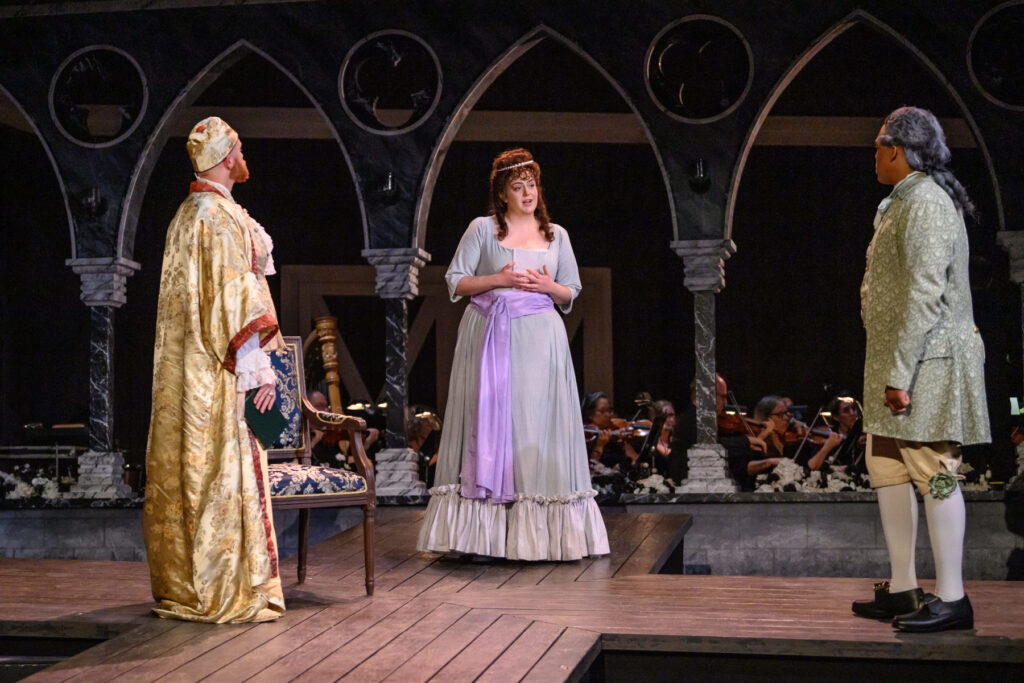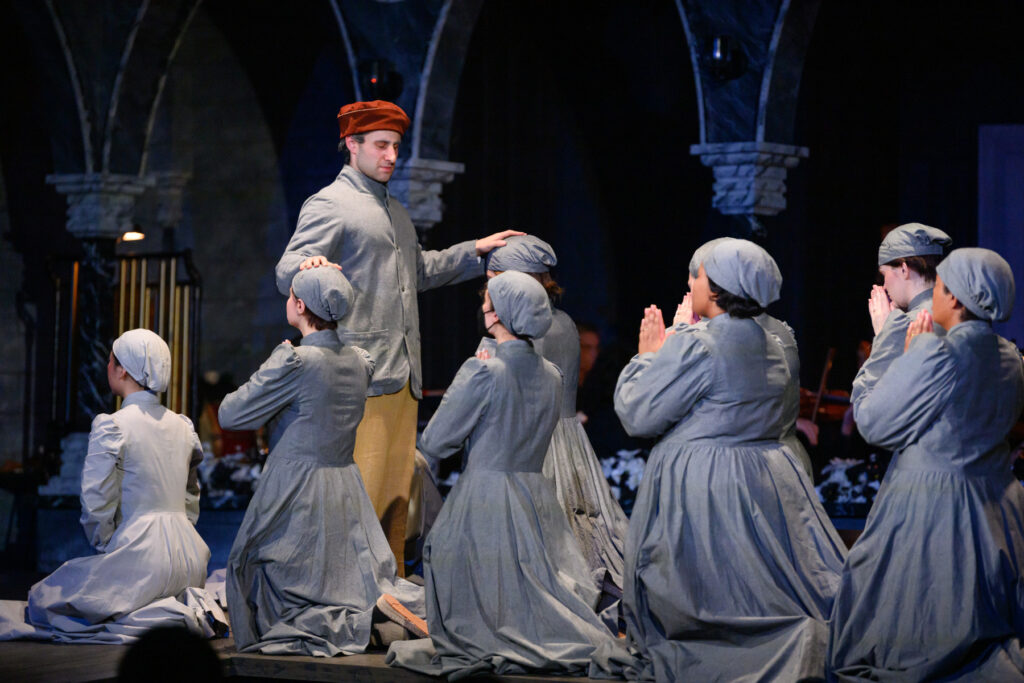What a delight to see the stage at The Barns so completely transformed from the set of Marriage of Figaro! It’s the first thing I noticed upon entering the venue. Not only were there platforms in the shape of a cross dominating the stage, but also church window arches revealing the orchestra not in a pit but at the back of the stage, behind the action, and the singers. This configuration with the orchestra at the back of the stage meant that at times it threatened to overpower the singers at the loudest moments, but not enough to detract from the experience as a whole. Geoffrey McDonald’s masterful music direction, however, as well as preparation by the singers and coaching, ensured that not a beat was missed.
This production’s design by Lawrence E. Moten III could be described as efficient, because it required no long scene changes. In the opening scene between the Chevalier (Travon D. Walker) and Marquis (Jonathan Patton) de la Force, there was only a chair to flesh out the setting. Patton gave a convincing turn as the Marquis, such that I hated to see the character gone in the second half of the show. Travon D. Walker as the Chevalier de la Force delivered a piercing tenor that also navigated a lovely falsetto in the second half, when the Chevalier visits his sister Blanche in the convent.

Speaking of, Erin Wagner as Blanche de la Force pleasantly surprised me with a colorful, full middle register. Her instrument is extremely stable, with a quality in that middle and lower register that I couldn’t help but liken to that of a mezzo-soprano’s, and it was in the second half, where Poulenc provides Blanche with a higher tessitura, that her voice really flourished. Interestingly, the composer’s writing for this role is lower in the first scene where she is still in the world and dressed in opulent 18th-century French garb, courtesy of the beautiful costume design by Caitlin Cisek, but higher in the second half when she has transformed into a Carmelite nun. Perhaps it is Poulenc’s musical way of indicating Blanche’s acceptance of and participation in a higher calling?
Leaving the world to become a nun is no small decision, and Cecelia McKinley’s portrayal of Madame de Croissy won’t let you forget it. I was immediately struck by her facility with the character’s physicality, using a cane to walk in her first scene and later writhing in pain on her bed as she dies. This character was lovable for the way she pulls no punches with Blanche: she tells the would-be postulant that becoming a Carmelite will not protect her from danger, and meditating on death doesn’t make passing any easier. McKinley added to the physicality and philosophy with a raw, unfiltered vocal performance, offering excellent low notes and plenty of squillo for a sound that pierced the theater. More than that, in her death scene she does not shy away from guttural screams as she uses the last of her strength to entrust Blanche to Mother Marie, played amazingly by Gabrielle Beteag.

Once Croissy died, Mother Marie’s part came to life. Beteag’s voice was explosive in this role, startling me in the scene where she scolded Blanche and generally melting my face off for the remainder of the opera. It’s a voice that stood out to me in particular as matching Poulenc’s score’s gripping intensity, and I would add only that it, as well as this opera in general, needed a larger hall to accommodate the wall of sound.
While Beteag took over the charge once her role got going, there were other standout vocal performances. Gemma Nha as Sister Constance brought a sense of humor to the beginning of her first scene. Wagner as Blanche towered over her, making Nha’s character all the more endearing, besides the fact that this role let her show off her fabulous high soprano.
While I ultimately thought the entire cast was amazing, special mention must also be given to Nathaniel Bear as The Chaplain. He took the audience to an emotional place one wouldn’t expect to go, forced to imagine what it would be like to have priests forbidden from saying mass and dressing in their vestments, that is to say, what it would be like to lose the right of religious freedom. And, too, Bear’s portrayal endeared the character to the audience especially during the voting scene, when he quietly hears each sister’s vote for or against martyrdom, then blesses all of them. The sisters singing with him was powerful, too. Poulenc writes glorious music both a cappella and accompanied for the ensemble, and I thought the singing of the “Ave Verum” in particular was worthy of stopping the show.
Katherine M. Carter’s direction is worthy of mention in no small part because the staging allowed the cast to really sing and focus on singing. The staging leaned toward static, but it never felt disengaged because of the variety of angles used. I also loved how respectfully the cast and the opera in general treated the nuns. After all, these were real women who really chose to be martyred with tremendous courage in the face of persecution, and this work and production successfully juxtaposes the terror they must have felt with the triumph of standing up for their freedom. This is an opera that deserves to be seen more, and I would see this production again in a heartbeat. Bravi tutti!
Maggie Ramsey
Dialogues of the Carmelites
Music and Libretto by Francis Poulenc
Cast and Production Staff:
Chevalier de la Force – Travon D. Walker; Marquis de la Force – Jonathan Patton; Blanche de la Force – Erin Wagner; Thierry/M. Javelinot – Robert Frazier; Madame de Croissy – Cecelia McKinley; Sister Constance – Gemma Nha; Mother Marie – Gabrielle Beteag; Madame Lidoine – Keely Futterer; The Chaplain – Nathaniel Bear; Sister Mathilde – Midori Marsh; First Commissioner – Timothy Anderson; Second Commissioner: Søren Pedersen; Mother Jeanne – Naomi Steele; The Jailer – Chandler Benn; Sister Alice – Arianna Rodriguez; Sister Anne of the Cross – Sophia Maekawa; Chorus – WTO Studio Artists
Conductor – Geoffrey McDonald; Director – Katherine M. Carter; Scenic Design – Lawrence E. Moten III; Costume Design – Caitlin Cisek; Lighting Design – Marika Kent; Hair & Makeup Design/Scenic Design Assistant – Anne Nesmith; Costume Design Assistant – Danielle De La Fuente; Lighting Design Assistant – Matt Lazarus; Wig & Makeup Assistant – Melissa Sibert; Principal Coach/French Diction – Marie-France Lefebvre; Chorus Master/Coach – Christopher Turbessi; Coach – Vladimir Soloviev; Supertitles – Julian Garvue; Assistant Director – Jessica Burton; Production Stage Manager – Annie Wheeler; Assistant Stage Manager – Bethany Windham
Vienna, VA, July 18, 2025
Top image: Madame de Croissy (Cecilia McKinley) and Mother Marie (Gabrielle Beteag)
All photos by Rich Kessler